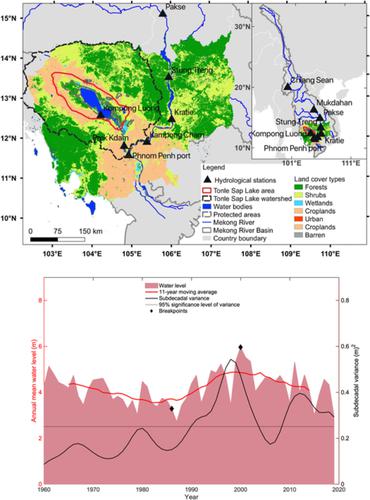当前位置:
X-MOL 学术
›
Hydrol. Process.
›
论文详情
Our official English website, www.x-mol.net, welcomes your
feedback! (Note: you will need to create a separate account there.)
Multidecadal variability of the Tonle Sap Lake flood pulse regime
Hydrological Processes ( IF 2.8 ) Pub Date : 2021-07-30 , DOI: 10.1002/hyp.14327 Aifang Chen 1, 2 , Junguo Liu 1 , Matti Kummu 3 , Olli Varis 3 , Qiuhong Tang 4, 5 , Ganquan Mao 1 , Jie Wang 4 , Deliang Chen 2
Hydrological Processes ( IF 2.8 ) Pub Date : 2021-07-30 , DOI: 10.1002/hyp.14327 Aifang Chen 1, 2 , Junguo Liu 1 , Matti Kummu 3 , Olli Varis 3 , Qiuhong Tang 4, 5 , Ganquan Mao 1 , Jie Wang 4 , Deliang Chen 2
Affiliation

|
Tonle Sap Lake (TSL) is one of the world's most productive lacustrine ecosystems, driven by the Mekong River's seasonal flood pulse. This flood pulse and its long-term dynamics under the Mekong River basin's (MRB) fast socio-economic development and climate change need to be identified and understood. However, existing studies fall short of sufficient time coverage or concentrate only on changes in water level (WL) that is only one of the critical flood pulse parameters influencing the flood pulse ecosystem productivity. Considering the rapidly changing hydroclimatic conditions in the Mekong basin, it is crucial to systematically analyse the changes in multiple key flood pulse parameters. Here, we aim to do that by using observed WL data for 1960–2019 accompanied with several parameters derived from a Digital Bathymetry Model. Results show significant declines of WL and inundation area from the late 1990s in the dry season and for the whole year, on top of increased subdecadal variability. Decreasing (increasing) probabilities of high (low) inundation area for 2000–2019 have been found, in comparison to the return period of inundation area for 1986–2000 (1960–1986). The mean seasonal cycle of daily WL in dry (wet) season for 2000–2019, compared to that for 1986–2000, has shifted by 10 (5) days. Significant correlations and coherence changes between the WL and large-scale circulations (i.e., El Niño-Southern Oscillation (ENSO), Pacific Decadal Oscillation (PDO) and Indian Ocean Dipole (IOD)), indicate that the atmospheric circulations could have influenced the flood pulse in different time scales. Also, the changes in discharge at the Mekong mainstream suggest that anthropogenic drivers may have impacted the high water levels in the lake. Overall, our results indicate a declining flood pulse since the late 1990s.
中文翻译:

洞里萨湖洪水脉冲状态的年代际变化
洞里萨湖 (TSL) 是世界上生产力最高的湖泊生态系统之一,受湄公河季节性洪水脉冲驱动。需要确定和了解湄公河流域 (MRB) 快速社会经济发展和气候变化下的这种洪水脉动及其长期动态。然而,现有的研究缺乏足够的时间覆盖或仅关注水位 (WL) 的变化,这只是影响洪水脉冲生态系统生产力的关键洪水脉冲参数之一。考虑到湄公河流域快速变化的水文气候条件,系统分析多个关键洪水脉冲参数的变化至关重要。在这里,我们的目标是通过使用 1960-2019 年观测到的 WL 数据以及从数字水深模型得出的几个参数来实现这一目标。结果显示,从 1990 年代后期开始,旱季和全年的 WL 和淹没面积显着下降,除此之外,次年代际变异性增加。与 1986-2000 年(1960-1986 年)淹没区重现期相比,已发现 2000-2019 年高(低)淹没区的概率下降(增加)。2000-2019 年干(湿)季每日 WL 的平均季节周期与 1986-2000 年相比,已经偏移了 10(5)天。WL 与大尺度环流(即厄尔尼诺-南方涛动 (ENSO)、太平洋年代际涛动 (PDO) 和印度洋偶极子 (IOD))之间的显着相关性和相干性变化表明大气环流可能影响了洪水不同时间尺度的脉搏。还,湄公河干流排放的变化表明,人为驱动因素可能影响了湖中的高水位。总体而言,我们的结果表明,自 1990 年代后期以来,洪水脉冲呈下降趋势。
更新日期:2021-09-10
中文翻译:

洞里萨湖洪水脉冲状态的年代际变化
洞里萨湖 (TSL) 是世界上生产力最高的湖泊生态系统之一,受湄公河季节性洪水脉冲驱动。需要确定和了解湄公河流域 (MRB) 快速社会经济发展和气候变化下的这种洪水脉动及其长期动态。然而,现有的研究缺乏足够的时间覆盖或仅关注水位 (WL) 的变化,这只是影响洪水脉冲生态系统生产力的关键洪水脉冲参数之一。考虑到湄公河流域快速变化的水文气候条件,系统分析多个关键洪水脉冲参数的变化至关重要。在这里,我们的目标是通过使用 1960-2019 年观测到的 WL 数据以及从数字水深模型得出的几个参数来实现这一目标。结果显示,从 1990 年代后期开始,旱季和全年的 WL 和淹没面积显着下降,除此之外,次年代际变异性增加。与 1986-2000 年(1960-1986 年)淹没区重现期相比,已发现 2000-2019 年高(低)淹没区的概率下降(增加)。2000-2019 年干(湿)季每日 WL 的平均季节周期与 1986-2000 年相比,已经偏移了 10(5)天。WL 与大尺度环流(即厄尔尼诺-南方涛动 (ENSO)、太平洋年代际涛动 (PDO) 和印度洋偶极子 (IOD))之间的显着相关性和相干性变化表明大气环流可能影响了洪水不同时间尺度的脉搏。还,湄公河干流排放的变化表明,人为驱动因素可能影响了湖中的高水位。总体而言,我们的结果表明,自 1990 年代后期以来,洪水脉冲呈下降趋势。











































 京公网安备 11010802027423号
京公网安备 11010802027423号